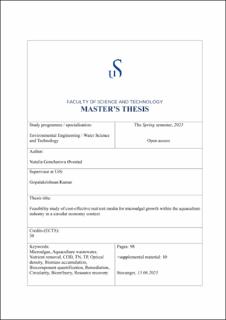| dc.description.abstract | Microalgal biotechnology has been growing and expanding tremendously in recent years in various sectors. Being metabolically flexible, microalgae can adapt to demanding and even extreme growth conditions. Multiple applications for microalgae itself and value-added products, obtained from algal biomass, are described in the literature. Meanwhile, costly nutrients for algal growth media make it economically inefficient and commercially not viable for scale-up production. To mitigate the economic impact of the cultivation stage on the end-product cost, wastewater from different industries can be used as a substitution for synthetic nutrient media.
The current research aimed towards the possibility to use ACWW as an alternative nutrient media for microalgae cultivation. Three microalgae species (Scenedesmus, Chlorella, and Nostoc spp.) were cultivated in nutrient media variants with different ACWW fractions (100%, 75%, 50%, and 25%) diluted with BBM. Growth parameters like optical density, biomass accumulation, and specific growth rate were monitored with different frequency in accordance with research goals. The highest biomass concentration under both constant and limited aeration was observed during cultivation of Scenedesmus sp. and was quantified as 0.991±0.073 g/L and 0.637±0.014 g/L respectively.
Simultaneously, wastewater treatment efficiency was monitored and evaluated in all cultivated samples by means of TN and TP removal. The peak TN and TP removal efficiency was observed while cultivating Scenedesmus sp. under constant aeration and amounted to 92.9% and 99.3% respectively. Relatively high nutrient removal results were obtained during Chlorella sp. cultivation under limited aeration which amounted to 40.4% and 98.2% for TN and TP respectively.
Subsequently, harvested microalgal biomass were subjected to the quantification of essential biocomponents (carbohydrates, proteins, and lipids) for further utilization in various applications. The results showed that dominating accumulated fraction in all the biomass samples was carbohydrates ranging from 54.2±3.6% to 62.3±6.4% in Scenedesmus sp. cultivated under limited aeration and from 29.4±3.0% to 44.5±18.7% in Nostoc sp. cultivated under limited aeration.
Overall, the results obtained through this approach provide the basic information towards the future applications of the biomass in various sectors such as biopolymer production. | |
